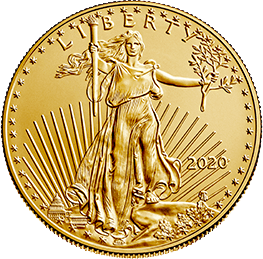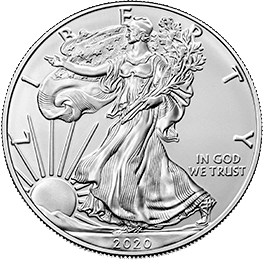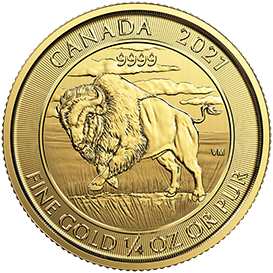
St. Gaudens Double Gold Eagle Coin
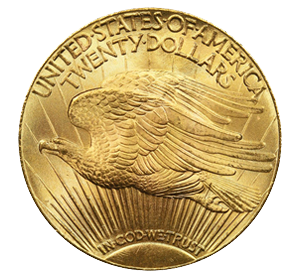
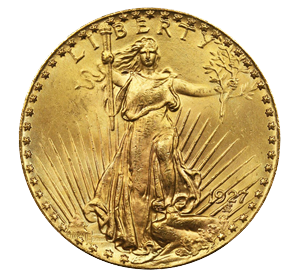


- This is one of the most magnificent gold coins ever minted. The coin has a heft that many collectors appreciate, and the St. Gauden’s Double Eagle’s details can be admired without a lens. This coin is the embodiment of all the hopes and dreams of the United States and was created by famed sculptor Augustus Saint-Gaudens at the behest of President Teddy Roosevelt after he saw a display of ancient coins at the Smithsonian. Roosevelt believed that America needed a new line of coins befitting the nation’s grandeur and greatness. Saint-Gaudens created a design for the ages and deserves a prominent place in your collection.
Coin Details
Coin Design
- Obverse: Features Lady Liberty holding a torch in front of her wit her right and an olive branch to her side with her left. He sun’s rays serve as a backdrop for this breathtaking image.
- Reverse: A heraldic eagle soaring high in the sky with the sun’s rays in the background
Free Insured Shipping
Price Match Guarantee
Buy-Back Commitment
History of St. Gaudens Double Gold Eagle Coins
The St. Gaudens Double Gold Eagle Coin is not just a gold piece – it’s a testament to American coinage’s artistic evolution. Crafted under the hands of sculptor Augustus Saint-Gaudens, this gold coin stands as an emblem of Liberty and American aspirations.
In the early 20th century, American coinage was poised for a transformation. The omnipresent Liberty Head designs had graced gold coins for decades, and there was a yearning for renewal and artistic elevation.
President Theodore Roosevelt recognized this need, believing in the power of art to inspire a nation. He envisioned coins matching the high-art standards seen in ancient Greek and Roman coinage. Roosevelt’s vision wasn’t just about aesthetics; it was a grand reimagining of American coinage to depict the country’s values, growth, and aspirations.
Saint-Gaudens’ Creation
Augustus Saint-Gaudens, one of the preeminent American sculptors of his time, was tasked with turning this vision into tangible gold coins. Roosevelt and Saint-Gaudens had a mutual admiration for one another, with Roosevelt once declaring Saint-Gaudens as the one who was “head and shoulders above all other American artists.”
Saint-Gaudens took on the challenge with vigor. He created a depiction of Lady Liberty that was both powerful and graceful. Striding forward confidently, she held a torch signifying enlightenment in one hand and an olive branch representing peace in the other. Behind her, the U.S. Capitol and the radiant sun portrayed the nation’s democracy and a bright future. This symbolized not just individual freedom but the forward momentum of the entire country.
However, the journey from design to mintage was challenging. While stunningly detailed and three-dimensional, the original high-relief design was difficult to strike and wasn’t practical for mass production.
The Early Minting Process
The U.S. Mint’s chief engraver, Charles Barber, was tasked with adapting Saint-Gaudens’ design to suit the minting process. This led to the creation of a flatter, more practical version. While some purists lamented the loss of the design’s depth and dimension, the revised version retained the essence and beauty of Saint-Gaudens’ vision.
In 1907, an even more captivating version was produced — the ultra-high relief double eagle. These coins required multiple strikes to reveal their intricate details and were more a proof of concept than a practical coin for circulation. Only a handful were minted, making them a treasured rarity today.
One more point worth mentioning was the omission of the “In God We Trust” motto from the initial design. Roosevelt believed using the deity’s name on coins was inappropriate and could be used for unsavory purposes. However, public outcry led to its reintroduction in later coin versions.
Even with their various challenges and iterations, the Saint-Gaudens Double Gold Eagle coins transformed American coinage. They married art and function in a way that’s still celebrated today, setting a standard for coinage design for years.
Minting and Circulation
Although the U.S. Mint in Philadelphia began minting the St. Gaudens gold coin in high relief in 1907, difficulties with the high-relief strike led to Charles Barber’s modifications, resulting in a lowered relief the following year. The coin had its share of variations, including the ultra-high relief, which only had a limited mintage and today resides in the Smithsonian. Other mints like Denver and San Francisco also contributed to its production.
Design Specifications and Mint Marks
The St. Gaudens double eagle gold coin is renowned for its intricate design. The Obverse featured Lady Liberty with flowing hair and robe, while the Reverse boasted a majestic flying eagle. Interestingly, some earlier versions did not have the “In God We Trust” motto, which was added later due to public demand. The coin’s mint mark, indicating its place of production (Philadelphia, Denver, or San Francisco), can typically be found on the obverse side.
St. Gaudens Double Gold Eagle Coins vs. Indian Head Gold Coins
The Saint-Gaudens Double Gold Eagle Coins blend artistic ambition and national symbolism. This coin, often touted as the most beautiful coin ever minted by the U.S., draws its design influence from classical art, mainly Roman and Greek numismatics.
The striking image of Lady Liberty confidently moving forward represents hope, progress, and the American spirit. Her robe flows and torch blazes, and the olive branch symbolizes peace — all attributes sculpted in high relief to give the coin an almost sculptural quality. The Roman numerals used in early versions of this coin pay homage to ancient coinage, further establishing its connection to classical art forms.
The Indian Head Gold Coins, on the other hand, offer a wholly different aesthetic. Also birthed from the period of redesign championed by President Roosevelt, this coin was primarily the creation of Boston sculptor Bela Lyon Pratt.
Unlike the high-relief splendor of the Saint-Gaudens coin, the Indian Head coins featured an incuse design — a technique where the design elements are sunken into the cash rather than raised. This approach was revolutionary for American coinage, making these coins a significant departure from the norm.
The obverse of the Indian Head gold coin showcases a proud Native American in profile, while the reverse carries a detailed portrayal of a majestic bald eagle. Both these images are deeply set into the surface of the coin. These design choices emphasized America’s indigenous history and deep connection to the land and its native inhabitants.
Value of St. Gaudens Double Gold Eagle Coins
The value of a St. Gaudens Double Gold Eagle Coin can vary significantly depending on the coin’s mint year, overall condition, and rarity. In general, coins in uncirculated condition are worth substantially more than those circulated.
Here are some examples of the current values of St. Gaudens Double Gold Eagle Coins in uncirculated condition:
1907 Ultra High Relief: $1,000,000+
1921: $500,000+
1927-D: $300,000+
1933: $7,500,000+
Double Gold Eagle Coins in circulated condition are worth significantly less than those in uncirculated condition. For example, a 1907 Saint-Gaudens in good condition may sell for around $1139 or close to the current price of gold. A 1908-S, on the other hand, may sell for over $8600 if in uncirculated condition.
If you have a St. Gaudens gold coin in great shape, you may want to send it to a professional coin grading service such as PCGS or NGC. This will accurately assess the coin’s value and help you sell it for the best possible price.
St. Gaudens Double Gold Eagle Coins are considered some of the most beautiful and valuable coins ever minted in the United States. They are a popular choice for collectors. If you are considering buying or selling a St. Gaudens Double Gold Eagle Coin, it is essential to research and understand the factors that affect its value.
Why Buy St. Gaudens Double Gold Eagle Coins?
Purchasing St. Gaudens Double Gold Eagle coins can be a good purchase for the following reasons:
1. Historical Significance
The St. Gaudens Double Gold Eagle Coin isn’t just a rare coin – it’s a snapshot of American history. Commissioned by President Theodore Roosevelt and masterfully crafted by Augustus Saint-Gaudens, it represents a period when America underwent a significant transformation.
2. Precious Metals Purchase
Gold has, for centuries, been a safe-haven asset, providing a hedge against inflation, currency fluctuations, and economic downturns. The St. Gaudens gold coin, composed primarily of gold, is a dual-purpose purchase. While its face value is twenty dollars, its intrinsic gold content and collectible value often make it worth much more.
3. Numismatic Value
Certain pieces stand out within coin collecting, and the Saint Gaudens Gold Eagle Coin is one of them. Its high-relief design, intricate detailing, and historical variations—like the ultra-high relief or the “No Motto” versions — make it a numismatic treasure. The coin’s appeal transcends mere gold content. It’s a work of art, a masterpiece of American coinage sought after by collectors worldwide, whether for its beauty, historical significance, or potential appreciation in value.
4. Certification and Authenticity
Like many collectible markets, the coin market is riddled with replicas and counterfeits. This makes authentication and certification paramount for serious collectors. St. Gaudens Double Gold Eagle Coins, when graded and authenticated by renowned agencies such as PCGS, NGC, and CAC, assure the holder of their genuineness and quality.
This certification validates the coin’s authenticity and often enhances its market value. A certified coin provides peace of mind to both seasoned numismatists and novice collectors, ensuring they possess a genuine piece of history.
As the trusted leader in precious metals, these heraldic coins can be purchased through American Hartford Gold today.
Sources:
Saint Gaudens $20 Gold Coin (1907-1933) Value | JM Bullion™
Saint Gaudens Double Eagle Mintage (1907-1933) | Coin Mintages
Saint-Gaudens double eagle | Wikipedia
Related Products
Get Your Free 2024 Guide

Most Recent News


From Bidenomics to Kamalafare

Gold as a Safe Haven During Political Upheaval
About American Hartford Gold
American Hartford Gold (AHG) the leading Gold & Silver Specialists that helps individuals and families diversify and protect their wealth with precious metals. Through our website, publications and expert Product Specialists, American Hartford Gold offers a wealth of precious metals market perspective that empowers both new and experienced investors.
Get Your FREE Gold & Silver Information Guide

CONTACT US
Los Angeles
11755 Wilshire Blvd. 11th Floor
Los Angeles, CA 90025
Phone: 800-462-0071
Email: info@hgoldgroup.com
Woodland Hills
21550 Oxnard Street Suite 705
Woodland Hills, CA 91367
HELPFUL LINKS
The statements made on this website are opinions and past performance is no indication of future performance or returns. Precious metals, like all investments, carry risk. Gold, silver and platinum coins and bars may appreciate, depreciate or stay the same depending on a variety of factors. American Hartford Gold. cannot guarantee, and makes no representation that any metals purchased will appreciate at all or appreciate sufficiently to make customers a profit. The decision to purchase or sell precious metals, and which precious metals to purchase or sell are the customer’s decision alone, and purchases and sales should be made subject to the customer’s own research, prudence and judgement. American Hartford Gold. does not provide investment, legal, retirement planning, or tax advice. Individuals should consult with their investment, legal or tax professionals for such services.
